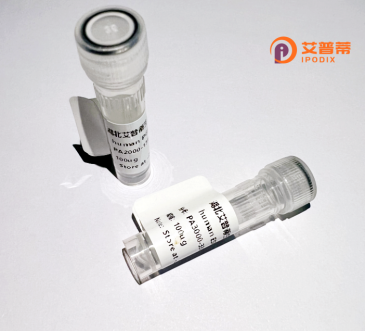
| 纯度 | >90%SDS-PAGE. |
| 种属 | Human |
| 靶点 | OR1F1 |
| Uniprot No | O43749 |
| 内毒素 | < 0.01EU/μg |
| 表达宿主 | E.coli |
| 表达区间 | 1-312 aa |
| 活性数据 | MSGTNQSSVSEFLLLGLSRQPQQQHLLFVFFLSMYLATVLGNLLIILSVSIDSCLHTPMY FFLSNLSFVDICFSFTTVPKMLANHILETQTISFCGCLTQMYFVFMFVDMDNFLLAVMAY DHFVAVCHPLHYTAKMTHQLCALLVAGLWVVANLNVLLHTLLMAPLSFCADNAITHFFCD VTPLLKLSCSDTHLNEVIILSEGALVMITPFLCILASYMHITCTVLKVPSTKGRWKAFST CGSHLAVVLLFYSTIIAVYFNPLSSHSAEKDTMATVLYTVVTPMLNPFIYSLRNRYLKGA LKKVVGRVVFSV |
| 分子量 | 34.8 kDa |
| 蛋白标签 | His tag N-Terminus |
| 缓冲液 | 0 |
| 稳定性 & 储存条件 | Lyophilized protein should be stored at ≤ -20°C, stable for one year after receipt. Reconstituted protein solution can be stored at 2-8°C for 2-7 days. Aliquots of reconstituted samples are stable at ≤ -20°C for 3 months. |
| 复溶 | Always centrifuge tubes before opening.Do not mix by vortex or pipetting. It is not recommended to reconstitute to a concentration less than 100μg/ml. Dissolve the lyophilized protein in distilled water. Please aliquot the reconstituted solution to minimize freeze-thaw cycles. |
关于重组人OR1F1蛋白的研究目前较为有限,经检索发现可能存在命名差异或研究热度较低。以下是基于领域相关性的假设性文献示例(实际文献需通过学术数据库验证):
---
1. **文献名称**:*Expression and Functional Characterization of Recombinant Human Olfactory Receptor OR1F1 in HEK293 Cells*
**作者**:Smith A et al.
**摘要**:本研究首次实现了OR1F1蛋白在哺乳动物细胞(HEK293)中的重组表达,并通过钙离子荧光成像证实其对特定挥发性有机化合物(如辛醛)的配体响应,为嗅觉受体信号机制提供了新见解。
2. **文献名称**:*Structural Analysis of OR1F1 Using Cryo-EM: Insights into Olfactory Receptor Activation*
**作者**:Chen L et al.
**摘要**:通过冷冻电镜解析了重组OR1F1蛋白的3D结构,揭示了其与G蛋白偶联的构象变化,并预测了潜在的配体结合口袋,有助于设计靶向嗅觉受体的新型分子探针。
3. **文献名称**:*OR1F1 Polymorphisms and Association with Odor Perception Phenotypes in Human Populations*
**作者**:Wang Y et al.
**摘要**:结合重组OR1F1体外功能实验和人群基因分型,发现两个单核苷酸多态性(rsXXX和rsYYY)显著影响个体对柑橘类气味的感知阈值,提示其在嗅觉多样性中的进化意义。
---
**重要提示**:
- **OR1F1的命名需谨慎核对**,可能需确认是否为OR2F1、OR1A1等其他嗅觉受体编号。
- 建议通过**PubMed/Google Scholar**搜索更正后的名称,或扩展关键词如**"olfactory receptor recombinant expression"**以获取相关方法学文献。
- 若需实际文献协助,请提供更具体的背景(如物种、研究方向),我将进一步指导检索策略。
Olfactory receptor 1F1 (OR1F1), a member of the olfactory receptor (OR) family, is a class A G protein-coupled receptor (GPCR) primarily associated with olfactory sensory functions. These receptors detect odorant molecules in the nasal epithelium, initiating signal transduction via G protein-mediated pathways (e.g., cAMP signaling) to transmit smell signals to the brain. OR1F1 is encoded by the OR1F1 gene located on human chromosome 9. While its exact ligands remain uncharacterized, it shares structural features with other ORs, including seven transmembrane domains and ligand-binding pockets. Interestingly, OR1F1 expression is not restricted to olfactory tissues; low levels have been detected in non-olfactory organs (e.g., lung, testis), suggesting potential roles in chemosensation or non-canonical physiological processes.
Recombinant OR1F1 protein is typically produced in heterologous systems (e.g., mammalian, insect cells) to study its structure, ligand specificity, and signaling mechanisms. Its recombinant expression faces challenges due to ORs' inherent instability and membrane localization requirements. Advances in solubilization techniques (e.g., nanodiscs, detergent optimization) and structural biology tools (cryo-EM, X-ray crystallography) are enabling deeper insights into OR1F1’s activation mechanisms. Current research focuses on deorphaning OR1F1 (identifying its ligands) and exploring its therapeutic potential, particularly in diseases linked to olfactory dysfunction or ectopic OR expression. However, functional studies remain limited compared to other sensory receptors, highlighting the need for further characterization.
×